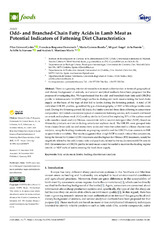Mostrar el registro sencillo del ítem
Odd- and Branched-Chain Fatty Acids in Lamb Meat as Potential Indicators of Fattening Diet Characteristics
| dc.contributor.author | Gómez-Cortés, Pilar | |
| dc.contributor.author | Requena Domenech, Francisco | |
| dc.contributor.author | Correro Rueda, Marta | |
| dc.contributor.author | Fuente, Miguel Ángel de la | |
| dc.contributor.author | Schiavone, Achille | |
| dc.contributor.author | Martínez Marín, Andrés L. | |
| dc.date.accessioned | 2021-01-08T12:17:50Z | |
| dc.date.available | 2021-01-08T12:17:50Z | |
| dc.date.issued | 2021 | |
| dc.identifier.uri | http://hdl.handle.net/10396/20945 | |
| dc.description.abstract | There is a growing interest of researchers in meat authentication in terms of geographical and dietary background of animals, and several analytical methods have been proposed for the purpose of investigating this. We hypothesized that the odd- and branched-chain fatty acid (OBCFA) profile in intramuscular fat (IMF) might suffice to distinguish lamb meat entering the food chain supply on the basis of the type of diet fed to lambs during the fattening period. A total of 30 individual OBCFA profiles, quantified by gas chromatography, of IMF of Manchego lambs were used. During the fattening period (42 days), the lambs were fed three diets differing in concentrate composition: (i) Control, concentrate typical of commercial fattening rations, rich in starch and based on cereals and soybean meal; (ii) Camelina, similar to Control but replacing 50% of the soybean meal with camelina meal; and (iii) Fibrous, concentrate rich in neutral detergent fiber (NDF), based on fibrous by-products and not including cereals nor soybean meal. The OBCFA were grouped into three classes (linear odd, iso and anteiso fatty acids) and were then submitted to a linear discriminant analysis, using the feeding treatments as grouping variable and the OBCFA class contents in IMF as quantitative variables. The results suggested that a high NDF to starch ratio of the concentrate, being the lowest for Control (CON) treatment and the highest for Fibrous (FIB) treatment, would be negatively related to the odd/anteiso ratio and positively related to the iso/(anteiso+odd) FA ratio in IMF. Determination of OBCFA profile in lamb meat would be useful to monitor the feeding regime (starch- or NDF-rich) of lambs entering the food chain supply. | es_ES |
| dc.format.mimetype | application/pdf | es_ES |
| dc.language.iso | eng | es_ES |
| dc.publisher | MDPI | es_ES |
| dc.rights | https://creativecommons.org/licenses/by/4.0/ | es_ES |
| dc.source | Foods 10(1), 77 (2021) | es_ES |
| dc.subject | Fatty acids | es_ES |
| dc.subject | Meat | es_ES |
| dc.subject | Lambs | es_ES |
| dc.subject | Feeding | es_ES |
| dc.subject | Discriminant analysis | es_ES |
| dc.title | Odd- and Branched-Chain Fatty Acids in Lamb Meat as Potential Indicators of Fattening Diet Characteristics | es_ES |
| dc.type | info:eu-repo/semantics/article | es_ES |
| dc.relation.publisherversion | http://dx.doi.org/10.3390/foods10010077 | es_ES |
| dc.relation.projectID | Gobierno de España. AGL2016-75159-C2-2-R | es_ES |
| dc.rights.accessRights | info:eu-repo/semantics/openAccess | es_ES |

